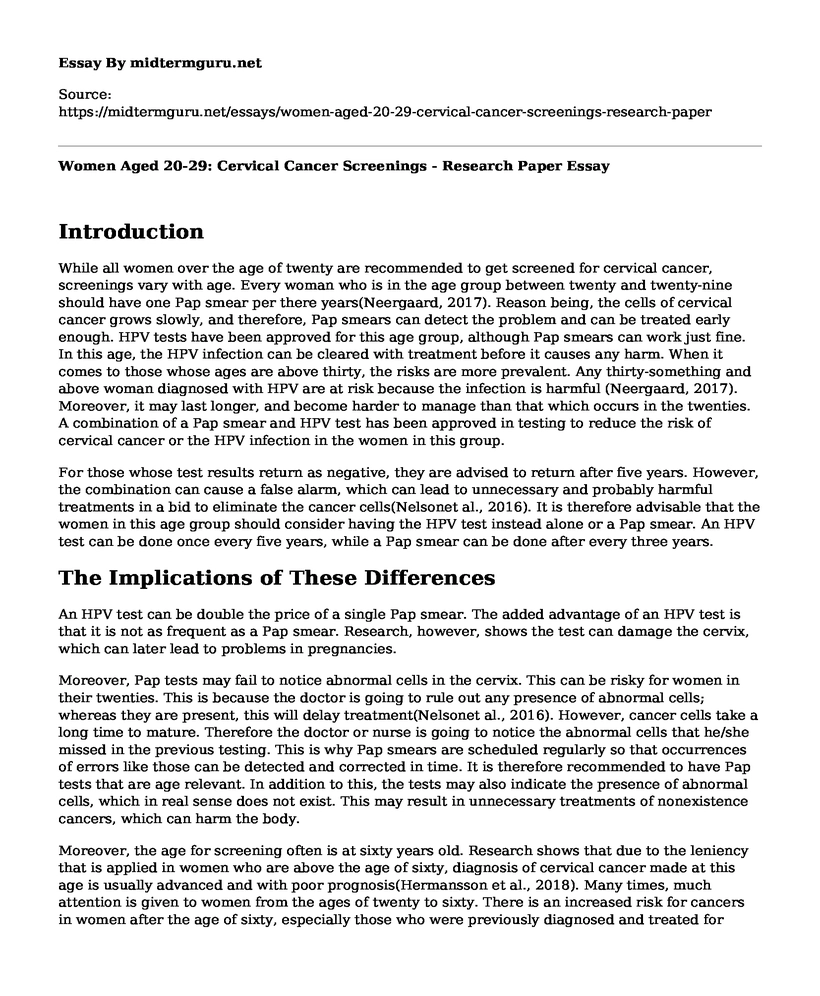Introduction
While all women over the age of twenty are recommended to get screened for cervical cancer, screenings vary with age. Every woman who is in the age group between twenty and twenty-nine should have one Pap smear per there years(Neergaard, 2017). Reason being, the cells of cervical cancer grows slowly, and therefore, Pap smears can detect the problem and can be treated early enough. HPV tests have been approved for this age group, although Pap smears can work just fine. In this age, the HPV infection can be cleared with treatment before it causes any harm. When it comes to those whose ages are above thirty, the risks are more prevalent. Any thirty-something and above woman diagnosed with HPV are at risk because the infection is harmful (Neergaard, 2017). Moreover, it may last longer, and become harder to manage than that which occurs in the twenties. A combination of a Pap smear and HPV test has been approved in testing to reduce the risk of cervical cancer or the HPV infection in the women in this group.
For those whose test results return as negative, they are advised to return after five years. However, the combination can cause a false alarm, which can lead to unnecessary and probably harmful treatments in a bid to eliminate the cancer cells(Nelsonet al., 2016). It is therefore advisable that the women in this age group should consider having the HPV test instead alone or a Pap smear. An HPV test can be done once every five years, while a Pap smear can be done after every three years.
The Implications of These Differences
An HPV test can be double the price of a single Pap smear. The added advantage of an HPV test is that it is not as frequent as a Pap smear. Research, however, shows the test can damage the cervix, which can later lead to problems in pregnancies.
Moreover, Pap tests may fail to notice abnormal cells in the cervix. This can be risky for women in their twenties. This is because the doctor is going to rule out any presence of abnormal cells; whereas they are present, this will delay treatment(Nelsonet al., 2016). However, cancer cells take a long time to mature. Therefore the doctor or nurse is going to notice the abnormal cells that he/she missed in the previous testing. This is why Pap smears are scheduled regularly so that occurrences of errors like those can be detected and corrected in time. It is therefore recommended to have Pap tests that are age relevant. In addition to this, the tests may also indicate the presence of abnormal cells, which in real sense does not exist. This may result in unnecessary treatments of nonexistence cancers, which can harm the body.
Moreover, the age for screening often is at sixty years old. Research shows that due to the leniency that is applied in women who are above the age of sixty, diagnosis of cervical cancer made at this age is usually advanced and with poor prognosis(Hermansson et al., 2018). Many times, much attention is given to women from the ages of twenty to sixty. There is an increased risk for cancers in women after the age of sixty, especially those who were previously diagnosed and treated for cervical intraepithelial neoplasia. Therefore, women who are past the age of sixty need to be monitored more carefully to avoid cancers.
References
Hermansson, R. S., Olovsson, M., Hoxell, E., &Lindstrom, A. K. (2018).HPV prevalence and HPV-related dysplasia in elderly women. Retrieved from https://journals.plos.org/plosone/article?id=10.1371/journal.pone.0189300
Neergaard, L., (2017, September 12). Age matters when it comes to screening for cervical cancer. Retrieved from https://www.statnews.com/2017/09/12/cervical-cancer-screening-age/
Nelson, H. D., O'meara, E. S., Kerlikowske, K., Balch, S., &Miglioretti, D. (2016). Factors associated with rates of false-positive and false-negative results from digital mammography screening: an analysis of registry data. Annals of internal medicine, 164(4), 226-235. Retrieved from https://annals.org/aim/fullarticle/2480755
Cite this page
Women Aged 20-29: Cervical Cancer Screenings - Research Paper. (2023, Jan 14). Retrieved from https://midtermguru.com/essays/women-aged-20-29-cervical-cancer-screenings-research-paper
If you are the original author of this essay and no longer wish to have it published on the midtermguru.com website, please click below to request its removal:
- Social Worker Placement: The Story of Betty
- Essay on Immunization Among Children
- Essay on Personal Health Assessment
- Essay on Familial Diseases Risks
- 6 Million Americans Affected by Congestive Heart Failure - Essay Sample
- Food Chains: Transferring Nutrients and Energy in Food Webs - Essay Sample
- Pharmacotherapy for Cardiovascular Disorder - Research Paper







